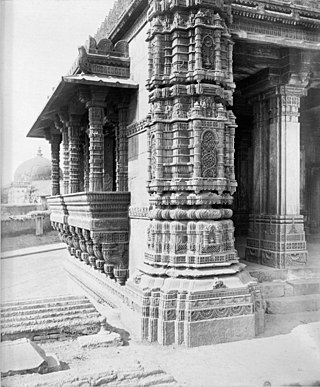
Rani Sipri's Mosque, also known locally as Masjid-e-nagina, and formerly known as Rani Asni's Mosque, is a mosque in the walled city of Ahmedabad, in the state of Gujarat in India. The structure is a Monument of National Importance.

The Jama Masjid, also known as Jumah Mosque or Jami' Masjid, is a Friday mosque, located in Ahmedabad, in the state of Gujarat, India. It was built in 1424 during the reign of Ahmad Shah I. The inscription on the central mihrab commemorates the inauguration of the mosque in AH 827 (1423/1424 CE), on the 1st Sarar, or January 4, by Sultan Ahmad Shah I. The mosque lies in the old walled city, and it is situated outside Bhadra Fort area. The old walled city is divided into separate quarters or pols, and the Jami' Masjid is found on the Gandhi Road. Along the south side of the road, the mosque is a short distance beyond the Teen Darwaza or Tripolia Gate. The structure is a Monument of National Importance.
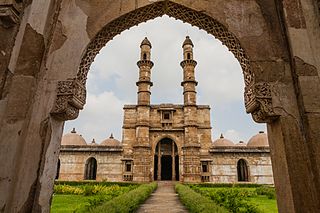
The Jami Masjid, also known as Jama Masjid; meaning "public mosque", is a former Friday mosque, now a well-preserved heritage site, located in Champaner, in the state of Gujarat, India. The mosque is a Monument of National Importance, and, together with other structures, is part of the Champaner-Pavagadh Archaeological Park, a UNESCO World Heritage Site, and is among the 114 monuments there which are listed by the Baroda Heritage Trust. The mosque is located approximately 46 metres (150 ft) east of the city walls (Jahdnpandh), near the east gate.

The Lila Gumbaj Ki Mosque is a former mosque, now a heritage site, located in Champaner, in the state of Gujarat, India. The mosque is a Monument of National Importance, and, together with other structures, is part of the Champaner-Pavagadh Archaeological Park, a UNESCO World Heritage Site, and is among the 114 monuments there which are listed by the Baroda Heritage Trust. It is located near the east gate of the former city.
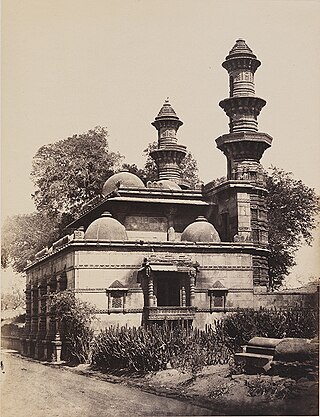
The Muhafiz Khan Mosque is a fifteenth-century mosque located in the city of Ahmedabad in the state of Gujarat, India. It is considered to be one of the more exceptional structures in the city. The mosque was constructed in 1465 by Jamail-ud-Din Muhafiz Khan during the reign of Mahmud Shah I (1458–1511), and is considered to be an excellent example of Mughal architecture. It is named for the governor of the region at that time.

Dastur Khan's Mosque, also known as Paththarwali Masjid, is a mosque in Ahmedabad, in the state of Gujarat. India. The structure is a Monument of National Importance.
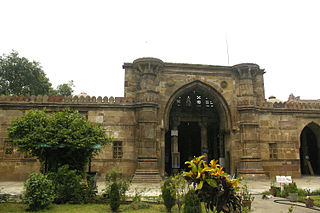
The Ahmad Shah's Mosque, also known as Shahi Jam-e-Masjid or Juni Juma Masjid, completed in 1414, is the oldest mosque of Ahmedabad, in the state of Gujarat, India. The structure is a Monument of National Importance.

Haibat Khan's Mosque is a mosque in Ahmedabad, in the state of Gujarat, India. The structure is a Monument of National Importance.
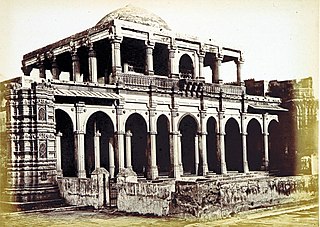
The Shahpur Mosque, also known as Shahpur Paththarwali Masjid or Kazi Mohammed Chishti's Mosque, is a Sufi mosque located near Shahpur Gate in Ahmedabad, in the state of Gujarat, India. The structure is a Monument of National Importance.

The Qutbuddin Mosque, formally the Qutb al-Din Shah Mosque, is a former mosque, now in partial ruins, built in 1449 in the Old City of Ahmedabad, in the state of Gujarat, India. The structure is a Monument of National Importance. Although the mosque is not considered a distinctive building by scholars, it exemplifies the progression of the Indo-Islamic architectural style of Ahmedabad in the 15th century.

The Saiyad Usman Mosque, alternatively spelled as Syed or Saiyyed, also known as the Usmanpura Dargah or Usmanpura Roza or Saiyad Oosman Mausoleum, is a Sufi dargah and mosque in Usmanpura, Ahmedabad, in the state of Gujarat, India. The structure is a Monument of National Importance.

The Achut Bibi's Mosque, also known as the Achut Bibi's Mosque and Tomb, and locally as the Shahi Masjid, is a Sufi mosque and dargah complex, located on the bank of Sabarmati River in Dudheshwar, Ahmedabad, in the state of Gujarat, India. The mosque structure is a Monument of National Importance.

Malik Alam's Mosque, also known as Peer Kamaal's Mosque, is a former mosque, now in partial ruins, in the Shah Alam area of Ahmedabad, in the state of Gujarat, India. The structure is a Monument of National Importance.

Rani Rupamati's Mosque, also known as Rani Rupavati's Mosque or Mirzapur Queen's Mosque, is a Sufi mosque and dargah complex in Mirzapur area of Ahmedabad, in the state of Gujarat, India. The structure is a Monument of National Importance.
Malik Isan's Mosque, also known as Isanpur Mosque or Gumle Masjid, is a former Sufi mosque, now in partial ruins, located in the Isanpur area of Ahmedabad, in the state of Gujarat, India. The structure is a Monument of National Importance.

The Jami Mosque is a Friday mosque in Khambat, in the state of Gujarat, India. Built in 1325, it is one of the oldest Islamic monuments in Gujarat. The mosque's interior is an open courtyard built with 100 columns.

The Lat Mosque is a mosque in Dhar in the state of Madhya Pradesh, India. Named after the Iron pillar of Dhar, it is also known as Lat ki masjid, Ladh Masjid, or Lath Masjid.
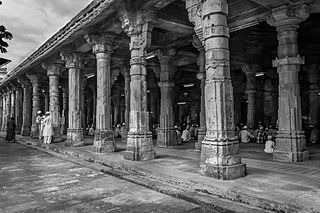
The Jami Masjid is a Friday mosque located at the top of the hill at Bharuch Fort in Bharuch, in the state of Gujarat, India. Built in the 14th century, it has three large domes, ten smaller domes and 48 pillars. The mosque was built in early 14th century; using the remains of a former Jain temple; and is a Monument of National Importance.

The Hilal Khan Ghazi Mosque, also known as Bahlol Khan Gazi's Mosque, is a mosque located in Dholka, in the Ahmedabad District of the state of Gujarat, India. Erected in AH 733 (1332/1333) by Hilal Khan Ghazi, a general during the Tughlaq dynasty, it is the oldest mosque in Dholka. The mosque is considered one of the most significant mosques of that historical period in its architectural style and artistic decorations.
The Lal Masjid is a mosque located in Tijara, in the state of Rajasthan, India. It is listed as a monument of national importance.




















